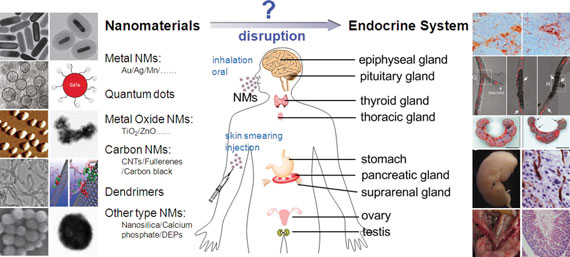Understanding Nanotoxicity: Assessing the Risks of Nanomaterials
What is Nanotoxicity?
Nanotoxicity refers to the potential adverse health effects caused by exposure to nanomaterials, which are materials with at least one dimension measuring less than 100 nanometers. As the use of nanomaterials increases in various industries, understanding and assessing their potential toxicity becomes crucial to ensure the safety of both humans and the environment.

Nanotoxicity is a central focus of the emerging field of nanotoxicology, which is the study of the potential adverse health effects caused by nanomaterials. Nanotoxicology is an interdisciplinary field that combines principles from toxicology, nanoscience, materials science, and molecular biology to understand the unique properties and behavior of nanomaterials in biological systems. By investigating the mechanisms of nanotoxicity and developing methods to assess the safety of nanomaterials, nanotoxicology plays a crucial role in identifying and mitigating potential risks associated with the development and use of nanotechnology. This knowledge is essential for the responsible advancement of nanotechnology applications in various sectors, including medicine, consumer products, and environmental remediation, while ensuring the protection of human health and the environment.
Factors Influencing Nanotoxicity
Several factors contribute to the potential toxicity of nanomaterials:
- Size and Surface Area: Nanomaterials have a high surface area-to-volume ratio, which can make them more reactive and potentially more toxic than their bulk counterparts. Smaller nanoparticles can penetrate cells and tissues more easily, increasing their potential for toxicity.
- Shape and Structure: The shape and structure of nanomaterials can also influence their toxicity. For example, long, fiber-like nanomaterials, such as carbon nanotubes, may cause similar health effects to asbestos fibers if inhaled.
- Chemical Composition: The chemical composition of nanomaterials can determine their reactivity, solubility, and potential for generating reactive oxygen species (ROS), which can lead to oxidative stress and cellular damage.
- Surface Functionalization: Modifications to the surface of nanomaterials, such as coatings or attached functional groups, can alter their interactions with biological systems and impact their toxicity.
Mechanisms of Nanotoxicity
Nanomaterials can cause toxicity through various mechanisms, depending on their properties and the route of exposure:
Oxidative Stress
Many nanomaterials can generate ROS, which can lead to oxidative stress in cells and tissues. Oxidative stress occurs when there is an imbalance between the production of ROS and the body's ability to neutralize them using antioxidants. This can result in damage to proteins, lipids, and DNA, potentially causing cell death and tissue inflammation.
Inflammation
Nanomaterials can trigger inflammatory responses in the body, particularly when inhaled or ingested. Inflammation is a natural defense mechanism, but chronic inflammation caused by persistent exposure to nanomaterials can lead to tissue damage and contribute to the development of diseases such as fibrosis and cancer.
Genotoxicity
Some nanomaterials can cause DNA damage, either directly through interactions with genetic material or indirectly through the generation of ROS. Genotoxicity can lead to mutations and potentially increase the risk of cancer.
Interference with Cell Signaling
Nanomaterials can disrupt normal cell signaling pathways by interacting with cell receptors, ion channels, or other signaling molecules. This can lead to altered cell function, apoptosis, or uncontrolled cell growth.
Assessing Nanotoxicity
Assessing the potential toxicity of nanomaterials is a complex process that involves both in vitro and in vivo studies:
In Vitro Studies
In vitro studies involve testing nanomaterials on cultured cells or tissues in a controlled laboratory setting. These studies can provide initial insights into the potential toxicity mechanisms and help identify nanomaterials that warrant further investigation. Common in vitro assays include cell viability, oxidative stress, and genotoxicity tests.
In Vivo Studies
In vivo studies involve testing nanomaterials in living organisms, typically animal models such as mice or rats. These studies can provide a more comprehensive understanding of the toxicity of nanomaterials, as they account for complex biological interactions and the potential for systemic effects. In vivo studies can assess acute and chronic toxicity, as well as the biodistribution and clearance of nanomaterials from the body.
Exposure Assessment
Assessing the potential for human exposure to nanomaterials is a critical component of nanotoxicity evaluation. This involves considering the routes of exposure (inhalation, ingestion, or dermal contact), the likelihood of exposure in various settings (occupational, consumer, or environmental), and the duration and frequency of exposure.
Risk Assessment and Management
Based on the results of toxicity studies and exposure assessments, risk assessment and management strategies can be developed to minimize the potential harm from nanomaterials. This may involve establishing exposure limits, implementing engineering controls and personal protective equipment in occupational settings, and developing guidelines for the safe handling and disposal of nanomaterials.
As the field of nanotechnology continues to advance, ongoing research into the potential toxicity of nanomaterials is essential to ensure their safe and responsible development and use.
Further Reading
Turkish Journal of Medical Sciences , Nanotoxicity: a challenge for future medicine
Journal of Materials Chemistry B, An overview of nanotoxicity and nanomedicine research: principles, progress and implications for cancer therapy
